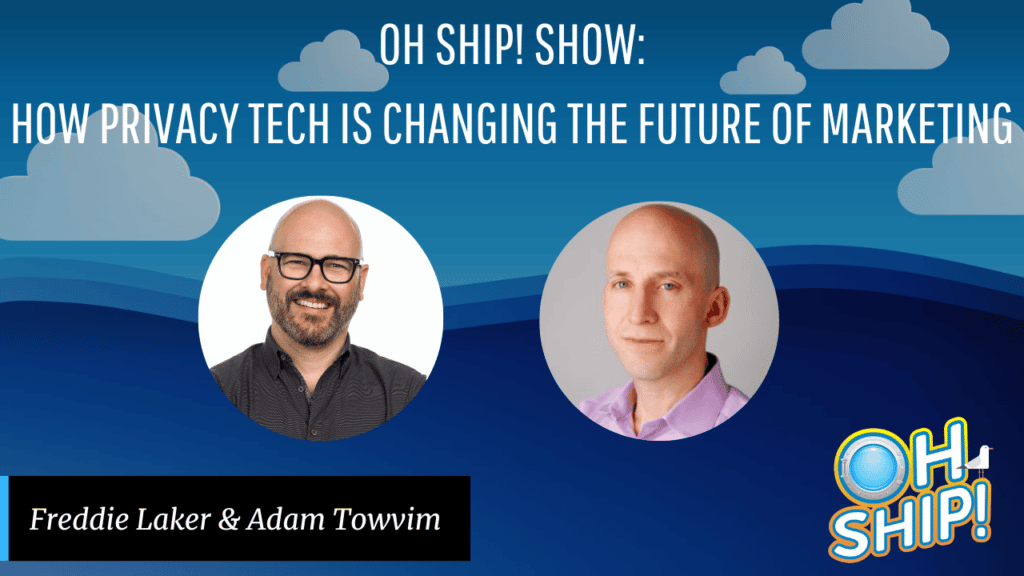Adam speaks on the implications of privacy tech developments on the future of marketing.

There’s a whole industry evolving around privacy, sparking new startups, careers, and opportunities—and Adam Towvim, partner at Chameleon Collective and self-proclaimed “privacy tech addict,” is a driving force within it. An advisor to numerous privacy groups and startups like Anonos, Qeepsake, and Jebbit, as well as cofounder of a couple of exciting startups himself, he’s also worked in leadership roles at firms like Jumptab. On Oh Ship!, he shared his take on what consumers really want, implications for the future of marketing, and how to launch a career in privacy tech.
Defining privacy
Privacy can take many forms: physical, behavioral, decisional, and information privacy. “It’s historically been called the right to be left alone,” Adam says. But it’s often mistaken with security. “Security is about protecting against the bad,” he says, quoting his cofounder of TrustLayer, Danny Wiessner. “Privacy is a scalable way to attest to the good.”
Today, large surveillance systems hold an incredible amount of data. For companies, affirming a commitment to responsible use of that data builds trust with customers.
What exactly does today’s privacy tech entail?
With his nuanced background, Adam views privacy tech from the lens of both consumers and businesses, who both demand these tools. Consumers are becoming increasingly concerned about how social platforms are monitoring and controlling their data—and they want solutions that clue them in.
“That’s what privacy tech means to consumers,” Adam explains. “The ability to monitor and have some control over the use of data, and participate in that in some way—and again, the right to be left alone when you want to be left alone.”
Many companies are using customer data to create customer personas, which may cause privacy concerns, Freddie notes.
Privacy solutions serve several key areas of need:
- Facilitating responses to consumer data requests
- Using consumer data in responsible ways
- Keeping the consumer data safe
A few companies have begun using automated workflows to respond efficiently to consumer requests for their data. “But how do you do that; how do you do it efficiently?” asks Adam.
Moreover, how can we facilitate responsible uses of data? This means designing processes that allow the appropriate data to be safely used in research, including collaborative efforts. And from a privacy tech addict’s standpoint, it means helping companies find more uses for the data that meet compliance requirements. “They’ve got AI, ML-driven algorithms, and they want to build privacy tech into that whole process,” he says.
From a privacy practitioner’s standpoint, showing you’re handling the data properly is crucial. “What happens when we let some of these algorithms run amuck… How do you avoid those algorithmic black holes?” he asks. Privacy tech can help avoid these scenarios.
On a scale of 1 to 10, how urgent is this? “This is a 10,” Adam says. It’s one of the hottest and most essential areas of business.
When did he become obsessed with privacy tech?
When Adam was just 10, he started working in BASIC, and he built up his programming skills in summer and college jobs. During the 2.5 and early 3G stages, while working in Germany, his concept of the volume and power of customers’ personal data really crystallized. Working with the world’s fastest-growing mobile telecom operator in a very privacy-aware country shaped his views on data privacy. “Large amounts of data exhaust can be really powerful, and you can use it a lot to expand the value of that data you’re gathering, but also, you need to be incredibly responsible along the way,” he learned.
What does “exhaust” mean? A data practitioner thinks about two aspects of data, he explains: customers’ profiles and the clickstream exhaust they generate. The latter encompasses where they go online—everything attached to their identifier. This includes everything from medical and claims data to what they buy. Privacy practitioners clean or pseudonymize that data, making it usable for research and marketing purposes but anonymous.
How much control of their data should everyday users have?
Privacy advocacy groups often assert that consumers should have 100% control of their data. While asserting that privacy should be a first-order concern for them—and that they should have the level of control that makes them feel comfortable—Adam wishes they had more awareness of how their data is actually used.
“I wish they knew more about how it is being traded on data and media platforms,” says Adam. “I also wish they knew how much it was being protected.” For instance, names aren’t typically attached to it.
“The challenge is, as consumers, there is a big difference between what they’re asking for—what we all think should be the case—and commercially what’s viable, and that’s what I love about the entrepreneurial scene,” he continues.
Everyday users don’t always understand that the “free” tools they have access to aren’t really free. “These everyday users are effectively paying for these services through the value of their data,” says Freddie. This is true even when it’s anonymized.
Users might engage in a value exchange to get access to free tools, Freddie adds. How could this work?
Consumers could get free assets in a game, or gated content, for instance. That would be much more viable than making cash payments, says Adam.
The challenges of data constriction
As data privacy regimes ask businesses and social platforms to go to greater lengths to protect data, advertisers can’t learn from it to the extent that they used to. This is a real challenge for businesses, Adam emphasizes. “It does create a problem, and it hits small businesses pretty hard the more we ask of the larger platforms to care for privacy,” he says.
Navigating the shifting terrain
The California laws CCPA (currently in effect), and CPRA, its successor, are changing the privacy landscape. They allow consumers to tell companies not to sell or share their data except under very specific parameters, like using it strictly for analysis.
All the recent changes around tracking people for ads have brought repercussions for small businesses. Many ad platforms have let small businesses broaden their reach through accessible tracking tools.
“It really hit small businesses hard for their ability to effectively just get the word out about their product and acquire new customers,” Adam says. And that gave more control to big businesses, Freddie notes. But overall, broad access to today’s platforms and third-party ad tech can bring more precision to their campaigns and better ROI on ad spend, Adam asserts.
Designing for the future
Changing privacy regulations force businesses to consider some big questions: “How are you architecting your whole customer data strategy? How are you thinking about your acquisition, retention, and marketing lifecycle economics?” says Adam. “Look at that and change out your whole customer data strategy so that you can better insulate yourself.”
Anyone holding personal data, like marketers, should design a data strategy that factors in how data privacy regimes may evolve over the next decade, he asserts. Businesses could be doing much more of that, with the widespread access to intuitive privacy tech tools tailored to collaboration, he notes.
Managing data storage
Businesses can also explore how to use data vaults to safely house data and make it accessible for valid purposes, says Adam. This is a pivotal development in privacy, and we’ll be seeing more portable vaults that expand access to this safer storage method.
Explaining data usage
Articulating how data is being used poses a challenge in itself. “Just own up and tell me how it’s being used,” people think, but that’s challenging and may sound indecipherable, Adam says. Nonetheless, try to distill the message into something customers can understand.
Starting a career in privacy tech
You can approach the field from different angles, Adam says. You can begin with training as a marketer, lawyer, engineer, or entrepreneur. For example, you could pursue an engineering degree and combine it with a law degree and a focus on privacy. Or, you could leverage career experience working in fraud and policy within a company at a functional, nontechnical level. If you have a marketing background, you can explain the value of a company’s privacy tech products to prospective customers.
An Oh Ship! moment in his career
A clear Oh Ship! moment happened to Adam in June 2007. In May, he’d joined Jumptap, and they’d raised almost $90 million in venture capital for their media network, which would allow networks like AT&T to shape how their customers search on mobile devices. Then in June, Steve Jobs announced the iPhone. “It completely cut out the carrier for huge amounts of content and mobile media that the carriers had been participating in,” says Adam. “And we had to pivot like crazy.”
This meant layoffs and going back to the drawing board about how to create value. “We had to recraft an entire company,” he says.
But they zeroed in on more relevant targeting, focusing on the profiles they’d created during the product evolution phase. “We set about really creating a whole new level of data on mobile that you could use in campaigns,” he says. “And it’s funny, we went from a search company to being an advertising company. And along the way, I think we became leaders in some of the early mobile privacy initiatives.” As a result, he became involved in cofounding industry standard bodies.
Advice for companies starting out in the privacy tech space
Your success hinges on finding a product-market fit for the data—discovering how to create value from it while maintaining the necessary level of privacy. Find the business that needs your help most critically and fill that gap, Adam advises. Encrypting data, handling privacy data subjects’ access requests, and using and sharing data collaboratively are several key areas of focus.
“These tectonic plates can shift under you,” Adam emphasizes, as his Oh Ship! moment shows. “You’ve got to come back to, what are you passionate [about], what gets you up in the morning?” Combine that with what differentiates you in the market, and you have a recipe for success.
Follow Adam on LinkedIn. And like and share for more great content!






